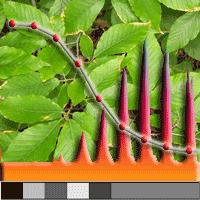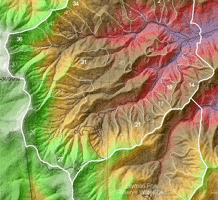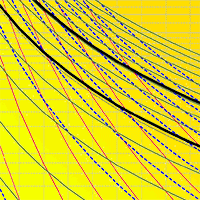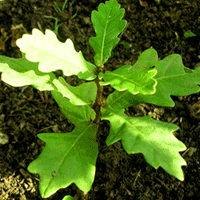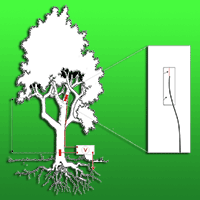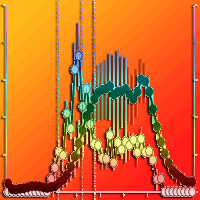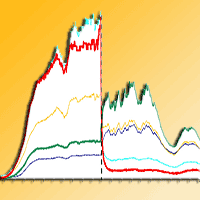
Revisiting the Heat Field Deformation (HFD) method for measuring sap flow
iForest - Biogeosciences and Forestry, Volume 11, Issue 1, Pages 118-130 (2018)
doi: https://doi.org/10.3832/ifor2381-011
Published: Feb 07, 2018 - Copyright © 2018 SISEF
Review Papers
Abstract
The Heat Field Deformation (HFD) technique is a thermodynamic method for measuring sap flow. Based on continuous heating the HFD method allows for high time resolution measurements which are highly important when studying plant responses to abrupt environmental changes. This work provides a succinct review of previously described features of the HFD methodology. Analyzing symmetrical and asymmetrical temperature differences around a measured linear heater (dTsym and dTas) relative to their ratio dTsym/dTas (so called a K-diagram) is at the heart of this methodology. This key concept, however, has to date only been generally described in previous works on the HFD technique. My objective here is to provide a comprehensive overview describing different types of K-diagrams, their interpretation and application for determining K-values or dTas for a zero flow condition. The K-value is a measured parameter which is particularly important for objectively characterizing heat conducting properties at the sensor insertion point under specific local measurement conditions. Correctly determining the K-value is critical for accurately calculating sap flow based on recorded temperature measurements. I have included in this review several examples demonstrating how the K-value is dependent upon changes to the environment and its important role in sap flow estimation.
Keywords
K-diagram, K/R-diagram, K-value, Sap Flow per Section, Sap Flux Density, Sensor
Authors’ Info
Authors’ address
Department of Forest Botany, Dendrology and Geobiocenology, Faculty of Forestry and Wood Technology, Mendel University in Brno, Zemedelská 3, 61300 Brno (Czech Republic)
Corresponding author
Paper Info
Citation
Nadezhdina N (2018). Revisiting the Heat Field Deformation (HFD) method for measuring sap flow. iForest 11: 118-130. - doi: 10.3832/ifor2381-011
Academic Editor
Jesus Julio Camarero
Paper history
Received: Jan 30, 2017
Accepted: Jan 17, 2018
First online: Feb 07, 2018
Publication Date: Feb 28, 2018
Publication Time: 0.70 months
Copyright Information
© SISEF - The Italian Society of Silviculture and Forest Ecology 2018
Open Access
This article is distributed under the terms of the Creative Commons Attribution-Non Commercial 4.0 International (https://creativecommons.org/licenses/by-nc/4.0/), which permits unrestricted use, distribution, and reproduction in any medium, provided you give appropriate credit to the original author(s) and the source, provide a link to the Creative Commons license, and indicate if changes were made.
Web Metrics
Breakdown by View Type
Article Usage
Total Article Views: 52082
(from publication date up to now)
Breakdown by View Type
HTML Page Views: 42389
Abstract Page Views: 4205
PDF Downloads: 4556
Citation/Reference Downloads: 22
XML Downloads: 910
Web Metrics
Days since publication: 2884
Overall contacts: 52082
Avg. contacts per week: 126.41
Citation Metrics
Article Citations
Article citations are based on data periodically collected from the Clarivate Web of Science web site
(last update: Mar 2025)
Total number of cites (since 2018): 20
Average cites per year: 2.50
Publication Metrics
by Dimensions ©
Articles citing this article
List of the papers citing this article based on CrossRef Cited-by.
References
Limitations of the HRM: great at low flow rates, but not yet up to speed? In: Proceedings of the “7th International Workshop on Sap Flow”. Seville (Spain) 21-24 Oct 2008. Book of Abstracts, International Society of Horticultural Sciences, Seville, Spain, pp. 57.
Gscholar
Measurement of sap flow dynamics through the tomato peduncle using a non-invasive sensor based on the heat field deformation method. In: Proceedings of the “9th International Workshop on Sap Flow”. Ghent (Belgium) 04-07 June 2013. Acta Horticulturae 991: 409-416.
CrossRef | Gscholar
Der Tagesgang der Geschwindigkeit des Transpirationsstromes im Stamme einer 75-jahrigen Fichte [The diurnal speed of the transpiration stream in the trunk of the 75-year old Spruce]. Oecologia Plantarum 3: 177-183. [in German]
Gscholar
A physiological algorithm of woody plant irrigation control under air drought. Fiziologia Rastenij 36: 972-979. [in Russian]
Gscholar
Temperature gradients around a linear heater due to moving sap. In: Proceedings of the “4th International Workshop on Measuring Sap Flow in Intact Plants” (Cermák J, Nadezhdina N eds). Zidlochovice (Czech republic) 3-5 Oct 1998. Publishing House of Mendel University, Brno, Czech Republic, pp. 65-71.
Gscholar
Heat field deformation method for sap flow measurements. In: Proceedings of the “4th International Workshop on measuring sap flow in intact plants” (Cermák J, Nadezhdina N eds.) Zidlochovice (Czech Republic) 3-5 Oct 1998. Publishing House of Mendel University, Brno, Czech Republic, pp. 72-92.
Gscholar
Differential translucence method as a supplement to sap flow measurement in Norway spruce with symptoms of top dieback. In: Proceedings of the “9th International Workshop on Sap Flow”. Ghent (Belgium) 04-07 June 2013. Acta Horticulturae 991: 285-292.
CrossRef | Gscholar
Heat method for continuous measurements of relative sap flow rate in xylem of woody plants. In: “Biophysical methods of studying ecophysiology of woody plants”. Nauka, Leningrad, Russia, pp. 68-95. [in Russian]
Gscholar
Thermoelektrische Registrierung der Geschwindigkeit des Transpirationsstromes [Thermoelectric registration of the speed of the transpiration stream]. Berichte der Deutschen Botanischen Gesellschaft 73: 221-226. [in German]
Gscholar


